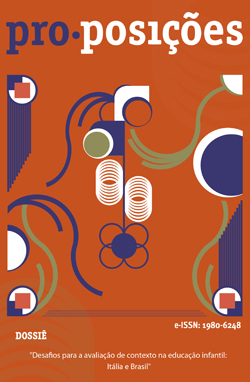Abstract
This article intends to address two conditions for the child to appropriate the reading and writing skills of the genre "tale": the characteristics of fictional narrative text and strategies of reading comprehension. Considering the theoretical assumptions of Propp, Claude Bremond, Harvey, and Goudvis, we will show how, in a specific experience, as opposed to what happens in the activities of textbooks, students experienced contact with this literature and how they articulated the understanding of narrative through proposed activities for this research. The results show that children, when involved in a consistent and meaningful way with fictional narrative text, assume the role of protagonists in both actions: the comprehension and the production of this textual genre.
References
Azevedo, R. (2000). Armazém do folclore. São Paulo: Ática.
Azevedo, R. (2011). Meu livro do folclore. São Paulo: Ática.
Bakhtin, M. (2003). Estética da criação verbal (4a ed.). São Paulo: Martins Fontes.
Brasil. (1998). Parâmetros curriculares nacionais: primeiro e segundo ciclos do ensino fundamental, Brasília: MEC/SEF.
Brasil. (2012). Ministério da Educação. Guia de livros didáticos: PNLD 2013: Língua Portuguesa, Brasília: MEC/SEB.
Bremond, C. (1972). A lógica dos possíveis narrativos. In R. Barthes (Org.), Análise estrutural da narrativa (110-135). Rio de Janeiro: Vozes.
Buranello, C. (2008). Língua Portuguesa (Coleção Conhecer e crescer, 4.º ano, 2a ed.). São Paulo: Escala Educacional.
Caldas, L. K. (2010). Trabalhando tipos/gêneros textuais em sala de aula: uma estratégia didática na perspectiva da mediação dialética. IBILCE/UNESP – São José do Rio Preto. Recuperado em 13 de agosto de 2015, de http://www.alb.com.br/anais16/sem03pdf/ sm03ss16_09.pdf.
Cardoso, J. B. (2001). Teoria e prática de leitura, apreensão e produção de texto. Brasília: Imprensa Oficial.
Davis, L., & Souza, R. J. (2010). Entendendo textos: estratégias para a sala de aula. Leitura: Teoria & Prática, 1, 31-37.
Fischer, D., Frey, N., & Lapp, D. (2008). In a reading state of mind: brain research, teacher modeling, and comprehension instruction. USA: IRA.
Fonseca, M. N. G. da, & Geraldi, J. W. (2002). O circuito do livro e a escola. In J. W. Geraldi (Org.), O texto na sala de aula (4a ed.). São Paulo: Ática.
Fountas, C., & Pinnell, G. (2001). Guiding readers and writers grades 3-6: teaching comprehension, genre, and content literacy. Portsmouth: Heinemann.
Hampton, M. F., & Resnick, L. B. (2009). Reading and writing with understanding: comprehension in forth and fifth grades. USA: IRA.
Harvey, S., & Goudvis, A. (2008). Strategies that work. Teaching comprehension for understanding and engagement. USA: Stenhouse Publishers & Pembroke Publishers.
Gancho, C. V. (2004). Como analisar narrativas. São Paulo: Ática.
Girotto, C. G. G. S., & Souza, R. J. de. (2010). Estratégias de leitura: para ensinar alunos a compreenderem o que leem. In R. J. Souza (Org.), Ler e compreender: estratégias de leitura. Campinas: Mercado de Letras.
Kleiman, A. (2002). Texto e leitor: aspectos cognitivos da leitura. Campinas: Pontes.
Lajolo, M. (1996, janeiro/março). Livro didático: um (quase) manual de usuário. Em Aberto, 16(69), 3-9.
Langenberg, D. N. (Ed.). (2000). Report of the National Reading Panel: Teaching children to read, an evidence-based assessment of the scientific research literature on reading and its implications for reading instruction. Washington, D. C.: National Institutes of Health Publication No. 00-4754. U.S. Government Printing Office.
Lerner, D. (2002). Ler e escrever na escola: o real, o possível e o necessário. Porto Alegre: Artmed.
Maingueneau, D. (2000). Termos chave da análise do discurso. Belo Horizonte, UFMG.
Marcurschi, B., & Val, M. G. C. (Orgs.). (2008). Livros didáticos de língua portuguesa: letramento e cidadania. Belo Horizonte: Ceale; Autêntica.
Pressley, M. (2002). Reading instruction that works: The case for balanced teaching (2nd ed.). New York: Guilford.
Propp, V. L. (2006). Morfologia do conto maravilhoso (J. Sarhan, Trad., B. Schnaiderman, Rev., 2a ed.). Rio de Janeiro: Forense Universitária.
Rojo, H. R. (2010, julho/dezembro). Letramentos escolares: coletânea de textos nos livros didáticos de língua portuguesa. Perspectiva, 28(2), 433-465. Recuperado em 28 de junho de 2016, de https://periodicos.ufsc.br/index.php/perspectiva/article/view/2175795X.2010v28n2p433/18444.
São Paulo (Estado) SEE. (2008). Proposta curricular do Estado de São Paulo para o ensino fundamental. São Paulo: SE.
Silva, A. C., & Carbonari, R. (1997). Cópia e leitura oral: estratégias para ensinar. In L. Chiappini (Org.), Aprender e ensinar com textos didáticos e paradidáticos. São Paulo: Cortez.
Solé, I. (1998). Estratégias de leitura (6a ed.). Porto Alegre: Artmed.
Souza, R. J., & Cosson, R. (2010). Letramento literário: uma proposta para a sala de aula. Conteúdo e didática de alfabetização, 10, 101-107. Didática dos Conteúdos. São Paulo: Cultura Acadêmica.
Souza, R. J., & Santos, C. C. S. (2011). A leitura da literatura infantil na escola. In R. J. Souza, Caminhos para a formação do leitor (pp. 80-89). São Paulo: DCL.
A Proposições utiliza a licença do Creative Commons (CC), preservando assim, a integridade dos artigos em ambiente de acesso aberto.


